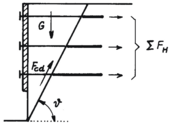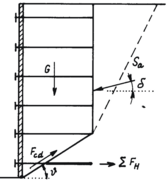Analysis of Internal Stability
Internal stability of a structure is checked assuming two types of a slip surface:
- Plane slip surface
 Plane slip surface
Plane slip surface
- Broken slip surface
 Broken slip surface
Broken slip surface
In both cases, a specific slip surface is examined for a variation of angle ϑ.
When running an optimization analysis the calculation is carried out for all benches with a variation of the angle of slip surface ν changing from 1 up to 89 degrees with a one-degree step.
A verification analysis of internal stability can be performed using either the factor of safety or the theory of limit states depending on the setting in the "Wall analysis" tab.
The analysis checks whether a ratio of resisting and shear (driving) forces acting on a slip surface is greater than the input factor of safety. The following forces are employed:
Shear forces:
- component of gravity force parallel to slip surface
- in case of broken slip surface - component of active earth pressure acting on the vertical part of structure and parallel to slip surface (pressure is determined without reduction of input parameters)
- horizontal forces due to earthquake
Resisting forces:
- soil friction and cohesion along the slip surface
- sum of the forces transmitted by nails